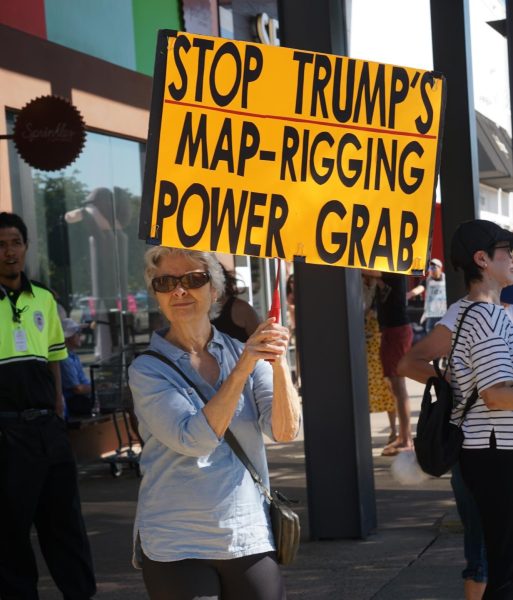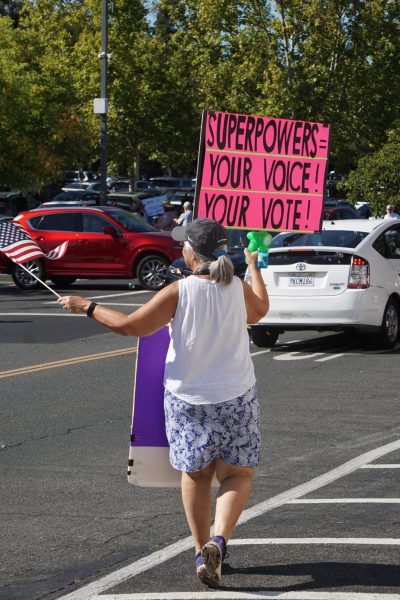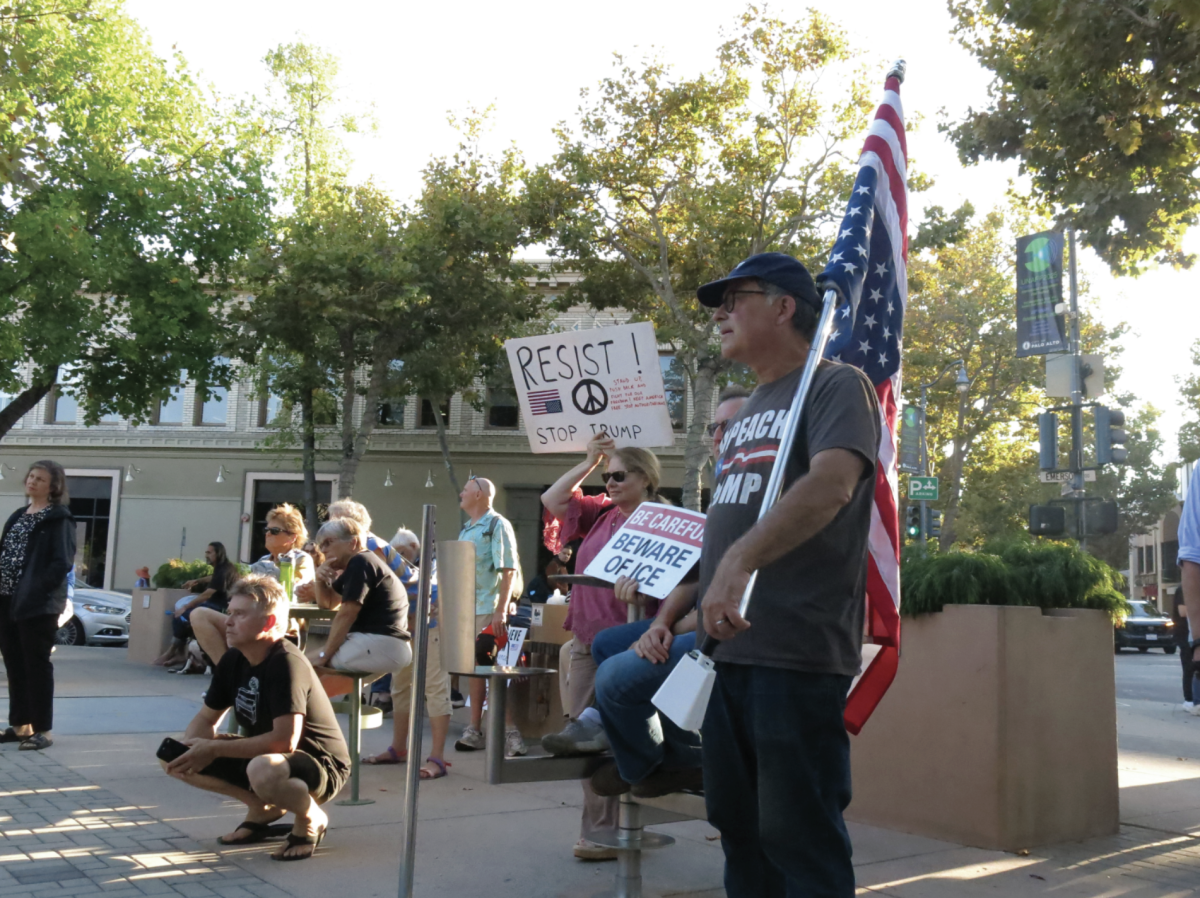A few dozen protesters march down University Avenue in Palo Alto on a Friday evening in mid-September.
A man with a megaphone calls, “Show me what democracy looks like!” The crowd behind him responds, “This is what democracy looks like!” Some protesters brandish American flags or rattle cowbells, while others hold picket signs. Signs urge passersby to “vote yes on Prop 50”.
The rally on Sept. 19 was organized by the local group Stand Up for Science and Sanity and encouraged the community to vote for Gov. Gavin Newsom’s new act, which aims to increase Democratic congressional power through new district maps. The maps would deliberately redistribute voters between new boundaries to maximize Democratic representatives.
Stand Up for Science and Sanity Founder Carol Peyser, a board-certified physician and psychiatrist in Menlo Park, created the organization in March to raise a community response against recent government initiatives. Peyser said President Donald Trump’s administration poses a real threat to American ideals.
“We need to get opposition up if we are going to save our democracy,” Peyser said. One way to do this, she says, is by supporting Proposition 50.
Stu Weiss, an environmental scientist who attended the protest, shares similar reasoning. He said there is too much at stake not to act.
“I wouldn’t normally support it [partisan gerrymandering], but these are not normal times, and we have to fight back any way we can,” Weiss said.
Many people do not associate gerrymandering with fighting for democracy. In fact, many people consider the practice undemocratic because it entails the deliberate creation of districts to minimize certain groups’ voting power.
If the practice is so corrupt, why are people chanting its praise through the streets?
According to Bruce Cain, a professor of political science at Stanford University, there are two kinds of gerrymandering: partisan and bipartisan.
“Gerrymandering means drawing the [Congressional district] lines to political advantage,” Cain said.
According to Cain, bipartisan gerrymandering makes both parties’ seats safer, while partisan gerrymandering makes both parties’ seats less safe, but gives one side an advantage. Partisan gerrymandering requires spreading voters from a party’s most secure districts across opposing districts, giving the party a chance to win much more representation.
The main reason partisan gerrymandering is rare, despite being legal in most cases, is that it requires a unique political climate to be worth the risk.

Woman uses picket signs to promote civic engagement at Labor Day Protest. (Amily Zhang)
Trump called for Texas to redraw its congressional districts to win more congressional seats for the Republican Party in the state in August 2025. The Texas legislature approved the new district maps later that month.
According to the California governor’s website, Newsom responded by announcing the Election Rigging Response Act, which would allow California to redraw district maps with the intention of counteracting the shift in Texas. Because Texas’s maps are projected to give five seats to the GOP, Newsom’s act aims to flip five California seats to democratic representatives. The new maps would be effective until 2030.
Though Texas’s district maps were immediately changed, California’s act must be voted on in a special election this November before maps are adopted, due to the state’s tighter restrictions on redistricting.
Another safeguard employed in California is the California Citizens Redistricting Commission, a nonpartisan group in charge of redrawing district lines at the turn of each decade. Under the Election Rigging Response Act, the commission would regain control of congressional map creation in 2030.
So why is California considering disregarding its standard procedures, which are in place to protect democracy?
The last time California executed a partisan gerrymander was in 1982, under the direction of the late John Burton, who was the chair of the Democratic Party. Cain worked with Burton in 1981 and 1982 to draw the gerrymandered congressional districts.
“So why did we do it? Because we had Reagan coming in, and people were almost as scared of Reagan as they are currently of Trump,” Cain said.
Cain said that California’s proposed deviation from the nonpartisan commission and application of this pointed political strategy is a direct result of the Democratic Party’s position regarding the president.
“Democrats are uniformly opposed to Trump and see him as a threat to the country—not just in terms of policy, but in terms of this sort of autocratic drift that we’re in,” Cain said. “He seems to be marshalling power for himself and trying to undermine elections.”
Cain argued that when the stakes are high, the government cannot always adhere to idealistic systems.
“Sometimes you have to suspend democracy,” Cain said. “That’s what emergency powers are. You have to suspend it during wars. You have to suspend it when we have hurricanes. We can’t just wait for all the normal procedures.”
Justin Cronin, a U.S. History teacher at Palo Alto High School, brings a different perspective to the issue. Cronin considers gerrymandering that disproportionately represents any demographic to be unethical. He believes the practice should be outlawed completely.
“It is supposed to be ‘people pick the politicians’, not ‘the politicians pick the people’,” Cronin said.
According to Cronin, if the Election Rigging Response Act passes, Republicans in the Central Valley and Northern California will be hurt. These areas will see district changes where historically Republican-governed areas are handed off to Democratic representatives.
“Many of the people in this state will not have true representation,” Cronin said.
According to the Fair Elections Center, this lack of representation creates a range of issues in affected communities, including dilution of voters’ political power and unfair distribution of resources.
“Gerrymandering also affects resource allocation, depriving certain communities of fair distribution,” the Fair Elections Center said on its website. “The resulting distortion of the voting public not only undermines the integrity of democracy but also fosters a sense of disempowerment among voters, potentially leading to lower voter turnout.”

Woman protests against redistricting at Labor Day protest. (Amily Zhang)
For Cronin, though, this issue extends beyond the 2026 midterm elections; it raises questions about national ideals.
“Isn’t that the whole thing that this country fought for independence for: the idea of representation?” Cronin said. “It [partisan gerrymandering] seems very counter to what we stand for … in this country.”
However, a different Paly teacher has another perspective on the issue. Social Justice Pathway history teacher Caitlin Drewes considers the California Citizens Redistricting Commission a sign of the state’s thriving democratic values.
“It’s something to be very proud of, and I think it is ultimately what we need across the country for really free and fair elections,” Drewes said.
She believes partisan gerrymandering is unethical and that safeguards like California’s commission are critical.
Today, though, she highlights the importance of context. She says the role played by the president in prompting Texas’s redistricting should not be overlooked.
“Right now we are not on an even playing field, and we have an administration that is actively trying to keep control of Congress in ways that are really unprecedented, [and] borderline illegal,” Drewes said.
Because of this unusual circumstance, she supports the movement to redraw lines for Democratic gain, calling it “a brave response from Gavin Newsom”.
However, Drewes also voices concern that this could be the start of a greater trend in America. She fears seeing increases in both gerrymandering and political polarization.
“By California doing this, we are potentially opening up a can of worms,” Drewes said. “We’re potentially opening up the door to even more chaos.”
